
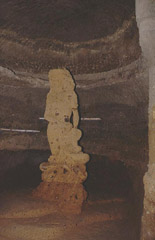
This page is about a civilized, well-organized, pleasure trip where everybody gained weight. If you're interested in the opposite (an uncivilized, chaotic, unpleasant trip where everyone lost weight), go to my home page and read almost any other travel story or Earthwatch trip. If you simply want to read about the worst one, take a look here.
I started taking Italian lessons almost on a whim. I had always liked the sound of the language and had some pretty good Italian friends, but most of all I liked the food, and was determined, someday, so eat my way across Italy. As far as I know, I have no Italian ancestors, and had no friends who lived there.
But one day I was having lunch with a friend named Caroline (and it wasn't even at an Italian restaurant—it was French), and she asked me how my studies of Spanish were going. I told her I was doing fine, but was a little bored, because although I'm far from fluent, I could certainly say pretty much anything I wanted, could understand most people, and most important, I could tell jokes with as much success as I have in English. I told her that it might be fun to start another one, and that at the moment, Italian would be on the top of the list.
Caroline said that she had studied Italian earlier and had always thought about working on it again since all of her ancestors were originally from Italy. She also pointed out that there was a language school across the street (Language Studies Institute) and that after lunch we should go over and check it out.
So to make a long story short, a half hour later I had signed up for 10 private lessons and Caroline had not.
Caroline and I met with my teacher-to-be, Emanuela, and I still wonder if Emanuela thought I was stupid or insane when I told her, "I've got a free month, and I'd like to learn as much Italian as I can during that month, since at the end of it I'm leaving on a trip to Peru."
I can imagine what went through her mind, "Does he think they speak Italian in Peru? Oh, well ... the customer is always right. Or maybe he's just insane."
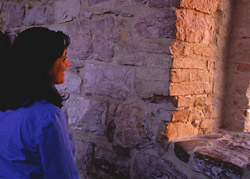
Here's a photo of Emanuela illuminated by the light through a window
in the wall near the main cathedral at Assisi. For this image, and
for any other image on the page, you can click on it to obtain a
higher resolution version.
Emanuela did warn me that shortly after I planned to return from Peru that she was going to accompany a bunch of her students to Italy for some Italian lessons, so there would be a pretty big gap in my classes due to my spending three weeks in Peru and then her spending three or four weeks in Italy.
But I was determined to get started. The July 4 weekend was coming up, so my first lesson was July 5, about 6 days in the future when I signed up. I was so excited about the lessons that I started at home with the worst possible professor—myself—and tried to see how much I could learn before the first class.
Anyway, I worked pretty hard on the language, and made pretty good progress. I think that the most important thing I did was to convert from drinking California wines to Italian wines, and to eat a lot more pasta.
After about three weeks, I had converted my sentences from 10% Italian and 90% Spanish to sentences that consisted of 50% of each, and Emanuela hinted that it might not be a total disaster if I joined her other students on the Italy trip. I thought about it for a week or so, and then just decided to go. At least I knew that I'd have a lot of great meals. The language school was in a little town named Todi that's in the center of the region of Italy called Umbria, and Todi is perhaps a couple of hours from Rome by automobile or train.
So I signed up at the last minute, and got airline reservations for Italy one day before I left for Peru.
I was down in the Amazon basin volunteering on a project where we studied hummingbirds ("colibri" in both Spanish and Italian) and I spoke Spanish perhaps half the time.
Well, after a month with Emanuela, it wasn't exactly Spanish, either—it was 50% Spanish and 50% Italian. But I was able, after three weeks in Peru, to eliminate almost all of the Italian influence. I did a lot of work with a friend, Wily, whom I met there last year, and who speaks not a word of English, but by the end I had him saying "Molto bene!" and "Arrivaderci!" So at least some of the Italian I left behind in Peru can still be found in Wily's vocabulary.
But the three weeks were pretty effective in completely smashing my Italian, and luckily there was time for two more one-hour sessions in the US with Emanuela before she took off. The first session was a disaster, but by the second, I was down to 60% Spanish, so there was a prayer that I'd survive in the Italian language school.
What is amazing is how prices drop as you get further from Rome, or rather, from the Rome airport. Just to get from the airport to the main Rome train station, on a train, cost about $7. The hour-long train ride from Rome to a town called Terni was about $5. And on the trip home I found that the situation was even more extreme.
To get to Todi you have to take two trains—one from Rome to Terni, and then another from Terni to Todi. There are, of course, two different railway systems, so you have to purchase tickets at two different places, Rome and Terni. When I got off the train in Terni, there was Emanuela! She had spent a week in Italy visiting her family and doing other things, and most recently had been in Rome. We were apparently on the same train from Rome to Terni, but in different cars. I was really pleased to see her, since in addition to having company for the final leg of the trip, I didn't have to pay really close attention to where we were going. On the trip from Rome to Terni, I kept my eyes glued to a map to make sure I didn't miss the stop—they didn't exactly announce which stations the train was stopping in.
We got off in Todi, where we were met by Paola, the person who basically runs the language school there, and she drove us into the center of town where we were delivered to our apartments.
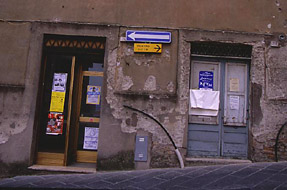
Here's an interesting combination of signs that I found on the
route between my apartment and the classroom. Above is the
blue and white "one way" traffic signal pointing to the left,
and below it is a sign pointing to the "Centro Città"—the
center of the city. Unfortunately, it points in the opposite
direction.
For some reason (Perhaps the time change—there's a nine hour difference between Italy and California. Or maybe that it was the fact that I ate like a pig ("maiale") on the airplane.) I was not at all hungry, so I wandered around the narrow streets of Todi for a few hours, and didn't even bother to eat dinner. I finally fell asleep at about 9 pm Todi time and woke up at about 7 am the next morning, so I figured I had beaten the jet-lag problem by simply inserting one 36 hour day into the cycle.
Wrong!
I couldn't get to sleep at all the next night either and was awake until about 3 am on Sunday. It took a couple of days with a few random naps before I felt synchronized. And as I write this, two days after returning, this exact text is being typed at 4 am in California, so I'm clearly screwed up on the return end as well. Normally the only world traveling I do is to Central and South America where there is a lot of north-south travel but not much east-west, and the time doesn't switch radically. (Although I did have a bit of trouble with Peru—although Peru is only two hours different from California when there's daylight-savings time, I also started getting up at 4:30 am to be ready to open the mist-nets to capture birds before the sun came up, so it was really more like a five hour time change for me. But at least in Peru there were coca leaves you could chew to ameliorate the problem somewhat.)
Anyway, during the day on Sunday I mostly wandered around Todi and took photos. I still wasn't too hungry, so I only had a couple of cappuccini and cornetti (cornetto = croissant, nella bella Italia).
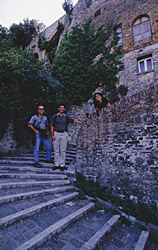
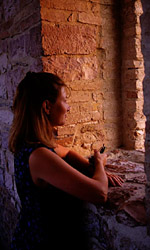
Here's Kristy at the same wall in Assisi where the photo of
Emanuela at the top of this page was taken. When you get good
light, take advantage of it! In the photo on the left are (from
left to right) Francobollo, Mike, and Emanuela.
I joked with Emanuela that I hadn't eaten anything—that I had only been ordering beer—and managed to substitute the Spanish word for beer ("cerveza") in place of the Italian in the sentence I spoke to her. Emanuela corrected me to "birra", so I said, "Oh, so that's why I never got any!"
I still haven't dared to get on a scale to see how much weight I gained, but that evening was the beginning. (Luckily I had lost about 5 pounds in Peru, but I'm sure I more than made up for that even during the first week.) We had a deal with a local restaurant that students at the school (The Language Center) could order either a pasta or a pizza, a "contorno" (a side dish, usually vegetables) and fruit for a prix fixe (oops, I guess that's French) of 15,000 lira. Since we could order that much, of course we did, every time. If you're interested in gaining some weight at a very reasonable price, I recommend the restaurant highly—it's called "Cavour", and is within a couple of blocks of the two main piazzas in Todi.
I got a pizza which turned out to be much larger than a standard dinner plate. It drooped over the edges by an inch or more (OK, by 3 or 4 centimeters) on every side. Then there was a giant side-dish of eggplant ("melanzana") and the fruit following. I ordered the "pizza verde" (green pizza) which was just cheese and a green topping of something like parsley, but I'm not sure what it was. Since I had finally learned the word "birra", I also got one of those, and was surprised to see that there were white, red, and green versions available. The white and red correspond to regular and amber beers here, but I had no idea what the green beer was, but considering that I was ordering the green pizza, it only made sense to order the green beer to go with it.
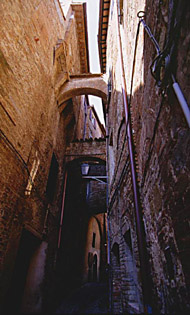
Many of the hill towns look so similar that it's hard to tell them
apart, and on this particular photo, I can't. I think it
was taken in Perugia, but it could have been in any town, including
Todi.
Well, in addition to having a brilliant green color, green beer is also "medicated" with a shot of vodka. The waiter made some comment about hoping that with the green beer and green pizza I didn't turn out to be green myself, and I sort of figured that had something to do with getting sick to my stomach or something, but Emanuela explained that being "green" means that you don't have any money—an interpretation which certainly wouldn't have occurred to an American who's used to thinking of money as all being green.
But it was thoroughly enjoyable. I turned out not to be green, so the waiter got his money. You couldn't ask for a nicer pair of people than Frank and Kristy, and with Emanuela at the table, we actually spoke in Italian for most of the time, which we probably wouldn't have done, left to our own lazy devices. Frank and Kristy were in the same apartment with Emanuela, and I had a giant apartment of my own 30 meters down the road. Frank was going to be there for the full two weeks, but Kristy only for one, when her husband would join her and they'd go traveling to other parts of the country.
After one week, Kristy left, and was replaced by one of Emanuela's best students, also named Frank. His Italian was spectacular. Arriving at the same time as the new Frank was Mike, who became my apartment-mate. Mike was not a student of Emanuela, but was good friends with one of her students named Firth, who will appear later in this story, and Mike's Italian was also quite good, but not quite as good as that of Frank number two.
To eliminate the difficulty with the double Franks, we called the first one "Francobollo" (meaning "postage stamp"). Or if we needed to talk about both of them, they were simply "i Franki".
Mike is seriously considering purchasing an apartment in Italy, and is there for about three months, sort of giving living in Italy a "test run". He's been there many times before, but I don't think ever for such a long period. He was doing things like making sure he could access and support his internet site, et cetera, and he spent a lot of time dealing with his laptop computer, the Italian phone system, and on that phone by voice with his internet service provider. He also learned some nasty lessons about arguing about a phone bill with a company in the US. For Mike to argue it cost 45 cents per minute, so he had to be sure that the net result of any such argument would be positive.
He was successful on the internet front, and here is his home page, which he updated regularly during the trip (and at least as of today, is continuing to update). He's got a lot of nice photos on the site, not only of Todi, but of other parts of Italy. He also has a lot more good people photos from Todi than I do.
He was a lot of fun, and late in the trip provided us (but probably not himself) a great deal of entertainment when not one, but two of his ex-fiancees showed up in Todi at the same time. Read on for details.
The other thing about Mike that sure surprised the three Japanese students at the school is that he spoke Japanese pretty well. Apparently he lived there for a year about ten years ago, and he must have been amazingly good at it then because so much of it remained, even after so long a time. I spoke a little Russian many years ago, and today would be hard-pressed to come up with more than a few words; Mike seemed to be constructing complete sentences, and in Japanese, which is a lot tougher to learn than Russian.
But to return to the first supper, after eating until our stomachs were on the verge of exploding, we went to a gelato shop and tried (unsuccessfully) to finish the job. Luckily, my apartment was only a hundred meters from the gelato place, and I was able to stagger home without assistance.

Here I am with Kristy and Emanuela in a museum in Todi. There had
just been a wedding, so we took advantage of the flowers. In fact,
we were in the wrong part of the museum, and immediately after this
photo was taken, we had to go find the real entrance.
There were two classes every day. The first ran from 9 to 11, followed by a short break (but long enough to get a cappuccino every day), and another from 11 to 1 with a different teacher. The teacher in my first class was named Andrea (a male) and the second was taught by Monica (a female, but that's probably easier to guess).
The first class was supposed to be a mixture of grammar, listening exercises, and conversation, and the second was to be primarily conversation. The first class was fine, but I was a bit disappointed in the second because it was almost no conversation. And for me, conversation was vastly more important than any of the other exercises. There are a lot of things I can do without a professor, like listen to tapes that have a transcription, or do grammar exercises where I have a solution sheet. But what I am completely unable to do on my own is to generate sentences in Italian and correct them. And the "generation" can be both oral or written.
I wanted to explain my complaint, but being relatively weak on the speaking end of things, I decided to write a letter, since I could work on it with a dictionary and a grammar book, and be pretty sure that it said exactly what I wanted it to. We were supposed to have dinner with Emanuela's crew and the owner of the school (Stefania) that night, so I wrote the letter during the afternoon. The letter was pretty clear, but unfortunately, being a written document, it probably carried more weight than it deserved, but it certainly had a large and wonderful effect. The next day, the second class changed from 0% conversation to virtually 100% conversation.
Both Stefania (the owner) and Paola (the director) of the school were lots of fun, and I thoroughly enjoyed the time I spent with them. If I'd walk by a bar where they were having a cappuccino, I always was invited in to join them, and on the final day when I was wandering around killing time until dinner, I ran into Paola, who invited me to wander around with her and her kids on errands and for a pizza (and a beer for me, naturally).
Stefania and Paola do a good job running the school, and they make sure everything goes smoothly. It's easy to recommend it to anyone. And of course I can say the same thing, but with even more certainty about Emanuela's school, since I've spent more time there. So if you're thinking of studying Italian, here are a couple of great places to start: Language Studies Institute in Palo Alto, California, and The Language Center in Todi, Umbria, Italy.
I hope Monica didn't get any black marks as a result of my letter; she was wonderful as a teacher. She even laughed (or at least pretended to laugh) at my jokes, she was very patient, and corrected errors to what I thought was exactly the right degree. If it was a written assignment, it was fully corrected, and during conversation, things were corrected normally, but if the student "got on a roll", and was actually generating Italian relatively smoothly, she'd let him/her continue through some minor errors and concentrated on the major ones. As soon as the 100% conversation classes began, she earned top marks from me in every one.
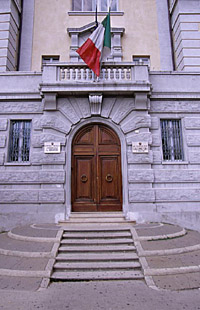
You'll probably have to click on this image to get the larger version if you want to be able to read the sign on this building, but if you've got a slow net connection, trust me, it says "Geometri". I'm a sort of a geometry nut (notice the domain name you're looking at), and this is the first time I had ever seen an entire building devoted to geometry.
Of course it's not Euclidean Geometry as I would have hoped, but the
name means that it's a sort of school of architecture. This building
appears just outside the Todi walls.
Andrea is fluent in English which was handy because when a word would come up where it was obvious that there would be a clean translation from English to Italian, I could just ask. Obviously it's nice to practice learning to talk your way around missing words, but I think you learn to do that with your first foreign language. But it is faster just to get the translation if it could obviously be looked up in a dictionary, and if the conversation is an important topic in itself, like a discussion of a point of grammar. So every now and then in the middle of a sentence with him I'd just put a helpless look on my face and say the English word, and it worked great.
Monica didn't speak English, but luckily her husband is Colombian, so she speaks mostly Spanish at home, so I'd just do the same trick of inserting a Spanish word (usually modified to a pseudo-Italian using my patented word conversion scheme, explained below) and put on the same helpless look, and it worked great, too. Monica also spoke fluent Russian, but it was a bit harder (but not impossible) for me to take advantage of that.
I'm not even sure exactly how my word-conversion scheme works, but it's pretty effective. Here are a few of the rules to convert Spanish to Italian (all the examples are written as "xxx->yyy", where "xxx" is the Spanish word and "yyy" is the Italian equivalent):
Actually, I've written a serious document with some suggestions for learning a foreign language (specifically Italian), and you can view an Acrobat version of that document here: learn.pdf or the PostScript version here: learn.ps.
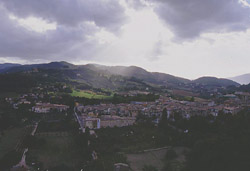

I think the image on the left is a view from the wall in San Gemini, but they all look so much alike I could easily be confused.
On the right is a photo of Todi, taken
from one of the city's walls with the camera pointed across a
place where the wall bends inward toward another wall.
But just because the classes were slow does not mean that they can't be made a little bizarre. For example, for homework one night Monica gave us a little comic strip without words, and we were to write a story that fit the strip. The story in the strip was blatantly obvious; a woman wears herself out preparing for dinner guests, and then falls asleep when they finally arrive. Here are the frames:
It wasn't easy, but I was able to come up with an alternative story. Monica had taught Italian in the Soviet Union, and in fact I noticed that the comic strip was not completely devoid of text; there was a calendar on the wall with the Cyrillic word for "June" on it. Monica had obviously made a copy of a page from a Russian textbook she had used there.
So it turned out that the woman in the comic strip was not just an ordinary housewife, but was Svetlana Kovalevskaya, one of the most brutal and dangerous members of the KGB. After having undergone plastic surgery, she had relocated to Italy, and was known as Monica, where she pretended to be a teacher of Italian. She had tricked her two former arch-rivals into coming to dinner for which she prepared a cyanide-laced stew. Knowing that she'd have to split the scene leaving a couple of bodies behind, she thoroughly cleaned the apartment to remove all traces—fingerprints, hair samples, et cetera. She felt lousy during the process, but was able to greet her enemies at the door. But what had occurred is that the weak acid in the stew had generated hydrogen cyanide gas that had poisoned Monica/Svetlana herself, and she died on the sofa in front of her guests/enemies.
I was able to "help" out the others a bit, too, even though they were in the advanced class. Frank had an assignment one day to write a letter of complaint to a company that had sold him a vacuum cleaner. It turned out that the vacuum cleaner was very dangerous, and Frank was supposed to ask for a refund or a replacement or something. I suggested, and Frank followed the suggestion, that the complaint be that he knew the vacuum cleaner was supposed to be dangerous, but that he had given it to his wife who had used it three times already, and was still alive, so he wanted his money back.
But I did manage to learn some Italian in spite of the fact that I spent a lot of time thinking up stories like those above. I'm sure that the experience was twice as good because Emanuela was there. We ate together as a group almost every day for lunch and dinner, and in fact Emanuela cooked a large number of meals for us in the apartment for which I am extremely grateful. And when we ate together, the conversation was in Italian (or Spitalish, in my case).
Most mornings Frank and Kristy and I went jogging with Emanuela before class and then stopped for a cappuccino. There's a nice park in Todi with a dirt trail loop that's about 1 kilometer around, and you could make as many loops as you wanted. Since I was more interested in gaining weight than in getting exercise, I kept the number of loops small, and concentrated on the cappuccino part of the experience.
While I was there, I purchased a good Italian to Italian dictionary which is loads of fun. Every time you look up a word, it has some words in the definition that you don't know, so you start on a grand adventure thorough Italian. And one night I had another adventure. For an essay I was writing I needed a bunch of names of particular diseases that did not appear in my little Italian to English dictionary, so I had to look them up in the big one. But "looking them up" was a little tricky, since I only knew the English version. I had to guess possible spellings and see if they appeared, and if so, was the definition the correct disease?
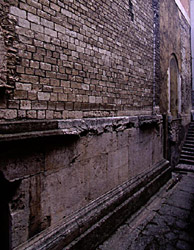
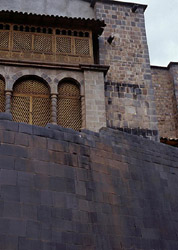
I probably liked the Roman stuff for the same reason I liked the Inca stuff in Peru. Often the Christian churches were built on top of Roman or Incan foundations, and almost without exception, the church part is falling apart, but the foundations are still solid as ever. Somebody sure went to a lot of trouble to make the church decorations, however. That was pretty amazing.
On the right is a church in Cusco, Peru, built on top of the
foundations of an Incan structure, just for comparison with the
Roman foundations on the left.
Also interesting is that similar to South America, people (or at least the women) seem to take the churches seriously, and there will actually be people praying there on days other than Sunday. I've never seen this in the US (although as I admitted, I have not investigated the situation thoroughly here).
And the following joke sort of sums it up:
Jesus Christ returned to earth to see how things were going, and his first visit was to an Italian (or South American) church. He hid himself up near the ceiling, and there, in front of the altar, was a woman thoroughly engrossed in prayer.He watched her for many minutes, and she gave no sign of stopping, so he decided to reward her for her faith. He whispered to her, "This is Jesus. I am here in the church with you."
But woman ignored him, and, if anything, began to pray more forcefully.
Thinking perhaps she hadn't heard him, he said again, but in a normal voice, "This is Jesus. I'm here in the church with you, and I am revealing myself as a reward to you for your obvious faith and devotion."
The woman ignored him, and prayed even more fervently.
So Jesus said, "Woman, this is Jesus, your lord and savior, and I am speaking to you. Answer me!"
The woman turned to face him and snapped, "Shut up kid. I'm talking to your mother!"
All in all, I probably spent more time in church during that two weeks than I have in the past 40 years.
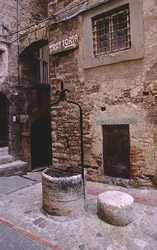

By the end, we toured the cities of Todi, Assisi, Spoleto, Orvieto, and San Gemini, and visited the Roman ruins at Carsulae. On Sunday, Emanuela's crew went to Perugia, so all in all we did see most of the major tourist attractions in Umbria. I remember that in the class the morning after the Todi tour, Monica asked us how it had been. Keiko and Maria explained all about the churches and stuff, and I related my fascination with the relationship of the water system with the sewer system, and the fact that the patron saint of Todi, Saint Jacopone, whose tomb is in one of the churches there, was a raving psychopath. I'm sure it was difficult for Monica to believe we were on the same tour. On the left is a well in Todi—part of the water (not the sewer) system, and on the right is a monument to Saint Jacopone.
Jacopone was born a rich, decadent guy who married some devout woman
and after her accidental death, something snapped in him. He dressed
in rags, ate dirt in his food to make it taste awful, and generally became
a thirteenth century street-person. He wrote a lot of religious poetry,
and then started accusing the pope of being a heretic which landed him
in jail for quite a few years, until the old pope died and a new one
was elected.
The tours, as well as all the other events were led by guides who spoke only Italian, but clearly it was a form of baby Italian, since I could understand almost all of it. Two of the guides were both named Nicoletta, and one of them had the most amazing way of using her hands as she talked, almost like a universal sign language to indicate the meaning of as many words as possible. The other Nicoletta was also quite good. The third guide was named Carlo, and although he was the nicest guy in the world, he had a pretty affected manner of speech which Emanuela loved to imitate.
Even as we entered, it was perfect; we were showered with laurel leaves.
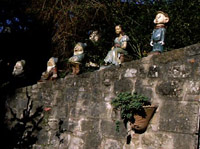
Is this a statue of Mary with some saints? Nope; it's Snow White
together with a bunch of her dwarves. All seven of them appeared on this
wall within Todi, but the light was so terrible that only these four
showed up. I never got a good explanation of this phenomenon, but it
occurred more than once. In a garden next to the place where we devoured
our Roman dinner was another collection of the famous characters, all
lined up.
There were probably 10 small courses, all good, and that was followed by a sort of game of charades by a couple of small kids who would act out animals and we'd try to guess what they were. Luckily, the kids were very small and the most difficult names were things like "frog", or "cow"—Italian words that even I knew.
That was followed by a more adult game. Well, it was more adult in the sense that the required vocabulary was more sophisticated; the game itself was perhaps more childish. It was sort of like a quiz from Cosmopolitan magazine where you answer each of a set of 19 questions, and at the end, a scoring key determines something about your personality type.
Basically, each question sought to determine whether you were more interested in food or sex. If food, you were an "Aphrodite", and if sex, a "Dionisus". Actually, there was a third option—Artemus, a rational person—but it was almost impossible to get that. On every question, you scored a 1, 2, or 3, so with 19 questions, the lowest possible score was 19 and the highest possible was 57. Of course most people scored toward the center at 38, and here's how the scoring was done: 0-19, Artemus; 20-38, Aphrodite; 39-57 Dionisus. It looks like there's a good chance to be an intellectual, but in fact, it's virtually impossible, since none of the scores from 0 to 18 are physically possible.
Carlo would read each question slowly, and then would give his interpretation. What was particularly funny is that there were certain words he wanted to be certain we understood, so he would repeat them and give definitions. To English speakers, at least, those words were usually the most obvious: "concubina", "sesso", "adulterare", "vomitare", et cetera. (Of course "concubina" (singular) never came up; it was always the plural form: "concubine".)
I scored 37; just barely on the food (Aphrodite) side.
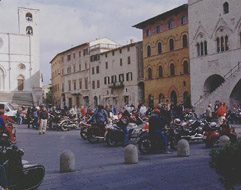

One morning, the entire piazza was filled with motorcycles. After
they hung out for a while, the whole group left Todi, single-file,
with a cop in front and an ambulance following ...
Only men showed up for the class—myself, the two Franks (i Franki), and Mike (and of course Marco, the teacher). Emanuela came in pretty late and missed all the fun with the puff pastry (except for eating it at the end, of course).
But after the dough was ready, we made all sorts of things, not just the cornetti. I've forgotten the names, but all were made with different fillings like custards, chocolate, raisins, nuts, et cetera. And all of them were out of the oven by the time we were done.
But what was really cool is that while we were waiting for the pastry to rise and to cook, Marco showed us how to make all sorts of marzipan animals. Obviously his looked a lot better than ours, but ours weren't so bad.
Then we made cappuccinos and had a pastry (or two). We split up all the pastries, so each of us had five or six to take home, and rather than eat them until we vomited, we took the far better course of taking them to language class the next day so that our classmates and teachers could eat them until they vomited.
Unfortunately, they ran out of space in the pizza cooking class, so I had to go see some churches instead.
Anyway, I got more evidence for something that I've really always known. I sat across from Paola, the director of the school, and afterwards she told me that for a while, at least, with each glass of wine, my Italian improved significantly. But it also started rapidly downhill somewhere in the middle of the third glass. I never did get around to implementing the plan I formulated there to drink a couple of glasses of wine every morning before class.
Then, after the dinner, we went to a wonderful choral concert in some other church. The instrumentalists were kids, perhaps in college, but the chorus was made up of adults. All my choral music is on old vinyl records, so I hadn't listened to it for a long time, and I'd forgotten how much I like Vivaldi.
I got to sit right behind the harpsichordist, so close that I could have touched her, and it was fun watching the action from close range. I don't know if this is true of all harpsichords, but this one could change its tuning by sliding all the keys to the left or the right by one position to put the keys under different strings and hammers. A block of wood replaced the key on the left or right to hold all the others in place. During the concert, the harpsichord was "retuned" in this way, but when the keys were moved, something wasn't quite right, and toward the middle of the keyboard, some of the keys began to sound two sets of strings. So the harpsichordist fixed it by pounding in credit cards next to the block of wood to push the keys further and further to the left. Finally, it worked, and the keys all played the new notes. I wonder how Bach and Vivaldi solved the problem without credit cards.
The bottom line is this: the only bad meal I had in Italy was on the last night in a little hotel near the airport outside of Rome. And even then, everything was ok except for the pasta which I suspect they overcooked because the only other customers seemed to be Americans from the midwest.
We did go to the best restaurant in Todi (called "Umbria") a couple of times, and although the food there was excellent, the prices were twice what they were elsewhere, and the food was not twice as good. I had some "cinghiale" (wild boar) there that was quite good.
For a bunch of lunches and a couple of dinners Emanuela was nice enough to cook for us, and every one of those meals was a hit. They were usually relatively simple meals, but prepared perfectly. It usually was a pasta with some wonderful sauce, some antipasto, and cheese or something. Oh, and of course, some wine.

We ate most often at the restaurant called Cavour, mentioned above,
and I tried about eight different types of pizza and three or four
of their main dishes. It was consistently good, especially with
a little too much beer. We were also blessed with the greatest
waiter in the world, Simone. He almost always ran; he hardly ever
walked. In the lower right corner is Frank (not Francobollo) with
a smile on his face that reflects the service that Simone is providing.
We also went to a seafood restaurant whose name escapes me (maybe it was something like "Sebaco"), but was right off the main piazza. It was the only place I ate something weird (not bad-tasting, just weird). They called it something like "polyps" ("polipo" in Italian, I think), but I don't think it was a cnidarian or a tumor. It seemed like a mollusk or something. It tasted fine.
But every day, I tried to eat at least one dish with truffles. Umbria is famous for them, and with good reason. I had boar with truffles, pasta with truffles, and pizza with truffles. I also brought a bunch of truffles home. (By the way, these are the mushroom truffles, not the chocolate ones.)
I failed miserably at my goal of having at least one gelato every day—there was just too much other good stuff to eat.
At first I thought the bread in Umbria was strange, and it is, in a sense. It's made without salt. It does taste a bit strange by itself, but it's made that way since the various meats that go into a typical Umbrian antipasto are usually salty, any extra salt in the bread would probably be too much. You just have to eat your prosciutto with your bread and it's perfect.
And then there were the liqueurs: grappa, limoncello, sambuca, ... Mike got me hooked on sambuca at the end of each day. It's licorice-flavored, and (served properly, which it wasn't, always) it should have three coffee beans floating in it.
The coffee was much simpler than at Starbucks. You could get a "caffe" (= espresso), a "latte", a "cappuccino", and a few others. If you wanted a "double espresso", you just get two caffes. I didn't try it, but I really like the concept of a "caffe corretto" (correct coffee), which includes some high-proof alcohol. I guess there was also a "caffe americano" available, but I never tried that.
At first, the meals were not completely out of control, but they soon got that way. On the first couple of nights, I was able to start on my homework by 9:30 pm or so, but toward the end, we figured out more and better ways to drag out dinner, and I'd begin my homework at 12:30 am. My classmates informed me that I seemed "totally wrecked" on the final two days.
The first part of the tour was another church. It (or rather its façade) is probably one of the most impressive in the world, but I didn't go inside because there was an entrance fee. It wasn't much—just a couple of dollars, but although my personal religion doesn't have too many rules, there is one that forbids me from paying money to go into a church. Everybody else went in for perhaps half an hour, so I wandered around downtown Orvieto trying to find interesting photo opportunities.
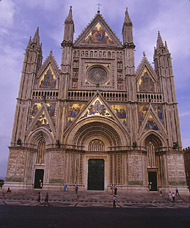
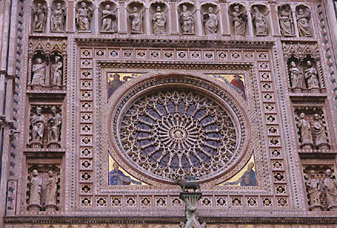
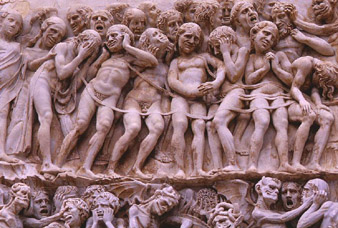
Above is the façade of the cathedral at Orvieto, a better view of the central part, and a close-up of some detail on the wall.
So we walked down the street to a little pastry shop and went inside to find a few tables and the pastry counter. I was getting all set to mope through the tasting when we were redirected out of the shop and a few doors down the street. Apparently we were going to taste in the wine cellar.
Well, the "wine cellar" turned out to be a giant archeological excavation of an Etruscan cave, right under the building. There was a maze of passageways and we kept twisting around and going down. Weird sculptures projected from the walls, as well as chunks of petrified wood, some carved statues, and piles of pottery shards. Eventually, we were 30 meters below the surface, and we could step into ancient wells and look up nearly 30 meters.
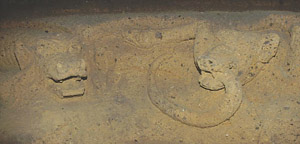
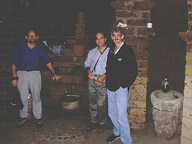
The cellar was cut in very soft rock called "tufa", and here is
a carving of a monster in the rock on the floor of the cellar, 30
meters below ground level. On the right is a shot of me on the
left, then Francobollo, then Frank.


On the left are some of the wine racks that were arranged along the
walls of the cave/cellar; on the right is a life-sized statue
carved from the same tufa as the monsters above.
There were, of course, dozens of giant wine racks installed against some of the walls, filled with bottles covered with mold. It was really something. Finally, we got to the lowest point where there was a table covered with antipasto and a few bottles of wine. They just made a "red" and a "white", so it wasn't really a tasting as in California, but a small meal with wine to go with it. The best part is that we didn't have to leave though a sales room where they try to pressure you into purchasing a case of wine on the way out.
Although at the surface, the temperature was quite warm, at the lowest point of the cellar where we ate, it was so cool that our breath condensed in front of us. All in all, it was a weird and wonderful place. The only downside, of course, is that having crammed my stomach at the tasting, I had a hard time eating as much as usual at our dinner when we returned to Todi.
When I was there, the Italian papers, day after day, had front page or even headline stories about Derek Rocco Barnabei, the guy who was executed in Virginia in September, 2000. Barnabei was almost certainly guilty of murder, but his parents are Italian citizens, and although Italy is very strongly opposed to the death penalty and regularly complains about the barbarity of the United States, this time the victim was "almost" Italian.
The papers carried extensive stories every day, with complete descriptions of the process, of all the appeals, et cetera. I was not in the US at the time, obviously, but I suspect there was almost nothing in the papers here. When I asked my wife about it when I returned, she hadn't noticed anything in the paper.
What was most interesting to me was that one day on the front page was an open letter to the United States signed by every member of the European Union that condemned the US for its continuing use of the death penalty. Apparently the letter had been sent to every major paper in the US, and it was published exactly zero times.
Madeline Albright, the secretary of state, issued a warning to us Americans in Italy warning us that there might be retribution against us if Virginia did carry out the execution. Every Italian I talked to about it found the warning absolutely hilarious.
One of them was staying with Mike's friend Firth (mentioned above) who was Emanuela's student who connected Mike and Emanuela, and the other happened to be on a bicycle tour of Italy and happened to drop in on Mike in Todi on exactly the same day as the other.
Firth was touring Italy with his mom, and I was really glad to be invited to dinner on my final night in Todi with Firth, his mom, Mike, the two women, and the husband of one of them. I confess that at first, I just wanted to see what happened.
But there were no fireworks, and they were all very nice people, so instead of having a great story to tell with all sorts of juicy details, all I can say about it is, "Ho, hum...another perfect meal in Italy."
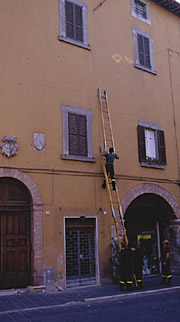

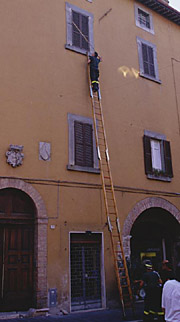
Here was one of the more bizarre things we saw in Todi. From left to right is a series of shots of some people who are putting a multiply segmented ladder on the building right next to Emanuela's apartment. They place a segment against the wall, and then somebody climbs the segment carrying another segment. The guys at the bottom then tilt the ladder away from the wall (while the poor sucker is still on top), and the poor sucker then adds his section to the ones below.
On the left, he's adding the third segment; in the middle, he's carrying up the fourth segment; and on the right he's doing the actual work—in this case, knocking some loose cement off of the edge of the window. It sure came down with a crash.
Then we got to watch him dismantle the ladder in exactly the same way.
They were pretty relaxed about it, as if they do this sort of thing every day.
So the next morning at 4 am I was really worried—the hotel would call a taxi, but there would only be one, and I'd be stuck with whatever the driver wanted to charge. So I asked the clerk at the hotel what the usual rate was, and the answer was 35000 lira, or about $17, which itself seems pretty exorbitant for a 4 minute ride. Anyway the guy came, and at least I had the sense to demand to know the price ahead of time, and he said, in Italian, 45000 lira. Since that was higher than the 35000, I hesitated for an instant, which was another mistake. He then said, in English, 55000 lira. I said he had just told me 45000 in Italian, but he insisted he hadn't, and that the price was a firm 55000 lira, or about $26. Since I didn't particularly want to miss the plane (and since it was so cheap compared to the 80000 the day before) I just paid. And this second ride only took 3 minutes. It was about 4:30 am, with no traffic, so he drove the whole trip at 100 kph, and ran every stop light and stop sign.
He told me the price was so high because he'd had to come all the way from Rome (45 minutes normally, but it only took him 5). Also, I had a suitcase and a backpack, and those were an additional 10000 lira each, so in fact 55000 lira was a really good price, especially for night work.
The funny thing is that when I was getting a hotel, I rejected the Hilton from which you can walk to the airport because of the high room rate. But the price of my hotel plus the two taxi rides was about the same as a room at the Hilton would have been, and the room surely would have been a lot nicer than the one I had.
I hated to leave Italy with a bad taste in my mouth, but at least at the horrible restaurant the night before I had overheard some even worse stories about getting ripped off in Rome.
But I got rid of the bad taste on the plane. I sat next to some gal and actually managed to hang on for about four sentences before she figured out I wasn't really Italian. (They were very simple sentences, to be sure.) And it wasn't quite fair, either. She was a native Spanish speaker from Puerto Rico who had learned Italian at the age of 4, but had lived in Italy and in the US afterwards. So she wasn't really a native speaker, and she might have been slightly insensitive to any errors I made that tilted toward Spanish, but she did say that for the first four sentences, she thought I was Italian, so I'll take full credit.
Actually, one of the things that makes Italy more attractive than Peru (as if there weren't a thousand others) is that it is conceivable that with a lot of study, I could pass myself off as an Italian. Even if I spoke perfect Spanish and perfect Qichua (the language of the indigenous people of Peru), it's always blatantly obvious that I'm a gringo.
Want to send me mail? Click here: tomrdavis@earthlink.net.
Return to my home page.